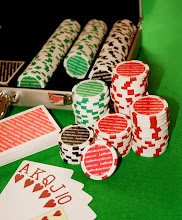So you have heard about poker from friends or seen it on television and now you have an interest in this great game. So, you first need to learn how to play, just like any other game. This blog will be dedicated to my favorite version called Texas Hold 'em (the game used in the World Series of Poker). Unlike Draw poker where players can choose to get (draw) replacement cards from their original deal, or Stud poker where other players can see some of your cards turned face up, Texas Hold 'em uses community cards that are shared by all players and only 2 cards face down for each player to determine the best hand. Also, to create action there are “blinds” paid by the 2 players left of the dealer (one “small blind” and one “big blind” that is usually twice the small blind) because they add money to the pot “blind” – before they even see their two hole cards.
So the play goes like this: Dealer gives 2 cards to each player face down, players peek at their cards and round 1 betting starts left of the big blind until all players are in for the same bet or folded. Next the dealer burns a card and deals the “flop” 3 community cards face up followed by a 2nd round of betting starting with player left of the dealer. Next the dealer burns a card and deals the “turn” single card face up followed by a 3rd round of betting starting with player left of the dealer. Finally, the dealer burns a card and deals the “river” single and last card face up followed by a 4th round of betting starting with player left of the dealer. If more than one player remains then the showdown (turning cards over) reveals the winner of the pot based on the best 5 cards. The best two hole or “pocket” cards does not always win. Betting can have pre-agreed limits (Limit Poker) or you can agree there is none (No Limit Poker) where your life can hinge on one “All In” bet. Next time I’ll discuss hand rankings (what determines the best hand) and then I will give you tips on breaking ties and split pots for equal hands.
(a good reference is The Little Black Book of Poker by John Hartley)
Thursday, June 11, 2009
Subscribe to:
Post Comments (Atom)



No comments:
Post a Comment